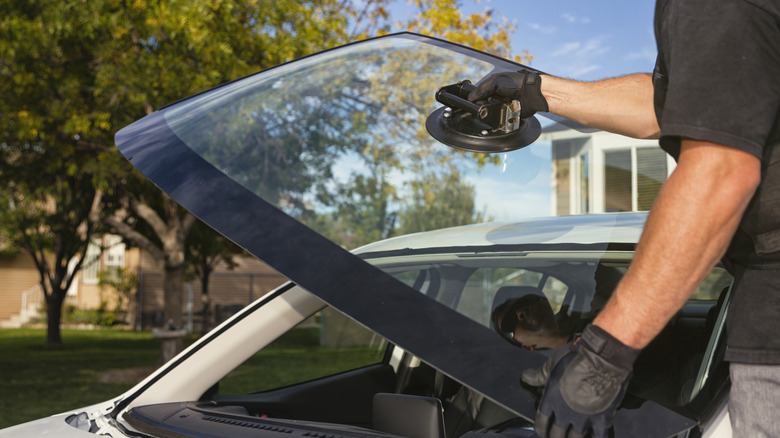Why Do They Put Blue Tape On New Windshields?
If you've ever had a chip develop into a crack, or been unfortunate enough to have something flick up from off of the road and cause significant damage to your windshield when driving, then chances are you've also had your windshield — or windscreen as they're called in England — replaced at some point. The process is pretty simple, and carried out by professionals who do the job day-in and day-out. While most steps, like removing the wiper blades and old shield from out of the way, plus then fitting and sealing the new shield make perfect sense, there is one final touch that might seem puzzling.
When finishing up, windshield fitters will attach blue tape across the edge and around the perimeter of the new shield. This is called retention tape, and it does serve a number of important functions, although the primary reason windshield fitters use it is to hold the windshield in place while the adhesive or sealant properly dries. It could take hours for this to happen, and in that time the windshield may shift ever so slightly, which could lead to an improper seal and then perhaps small leaks or even the shield popping out slightly over time. By using retention tape, which might not always be blue but typically is, windshield fitters can rest assured knowing that the new shield will remain in place.
Other ways in which retention tape works to protect new windshields
While the primary purpose of retention tape is to keep the windshield in place, it does serve a number of other useful functions. For instance, it also stops contaminants from soaking into the adhesive while it's curing. This could be water, dirt, and just about anything else. Contaminants like this could weaken the effectiveness of the adhesive, so covering the perimeter of the shield with retention tape helps to prevent this while it properly dries. Speaking of which, be sure to ask the fitter how long you should leave the tape on if they don't make it clear to you prior to leaving. While it shouldn't take long for the windshield to be fitted, fitters typically request that the tape stay on for 24 hours, but in particularly cold or wet weather, the fitter may request you leave the tape in place for up to 72 hours.
Other benefits of retention tape include preventing vibration of the windshield and helping the adhesive to maintain a constant and optimal temperature. Vibrations and fluctuating temperatures could reduce the adhesive's protectiveness, as could direct sunlight, and retention tape works to reduce the risk from these variables. Once the adhesive has properly cured, it's safe to remove the tape. A favored method is to heat it up with a hair dryer and then peel from the edges, keeping an eye out to ensure the adhesive looks fully cured and not sticky. Any leftover residue from the tape can carefully be removed with a razor blade, but if you're unsure, just reach out to your windshield fitter and seek professional advice so as to not damage your new shield.

